Moto Guzzi V85 TT Review
Motorcycle Test by Trevor Hedge
Images by iKap & Moto Guzzi
Moto Guzzi’s all-new V85TT is a welcome new offering in the mid-capacity adventure-touring segment and one that spurned a lot of interest on social media when we first highlighted the pending arrival of the machine on MCNews.com.au.
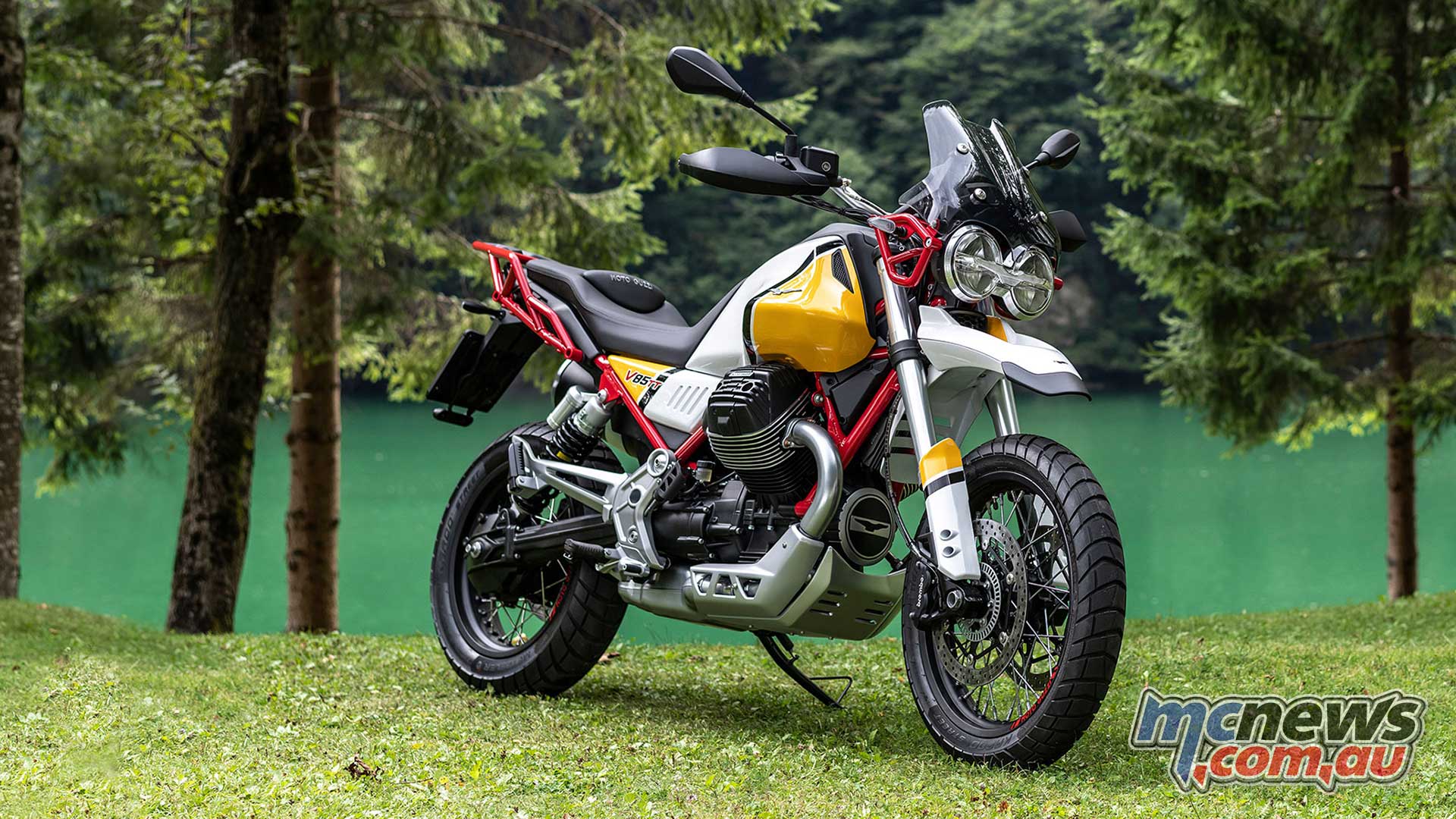
Guzzi’s most recent, but now discontinued, adventure bike model, the Stelvio, was an all-roads touring bike. The Stelvio was not built for serious dirt tracks with rock strewn climbs, but instead for mega mile-munching, with few stops required thanks to its 32-litre tank. However, it was competent enough to take on reasonably well formed trails, and in NTX guise scored spoke rims and engine guards. It was powered by a very charismatic, but moderately powerful, 1151cc V-Twin that in its final 8V incarnation mustered 104 horsepower and 113 Nm of torque. It was comfortable and enjoyable, but at over 270kg it was not the best tool in the shed for negotiating tricky side-tracks in the hands of moderately talented riders.
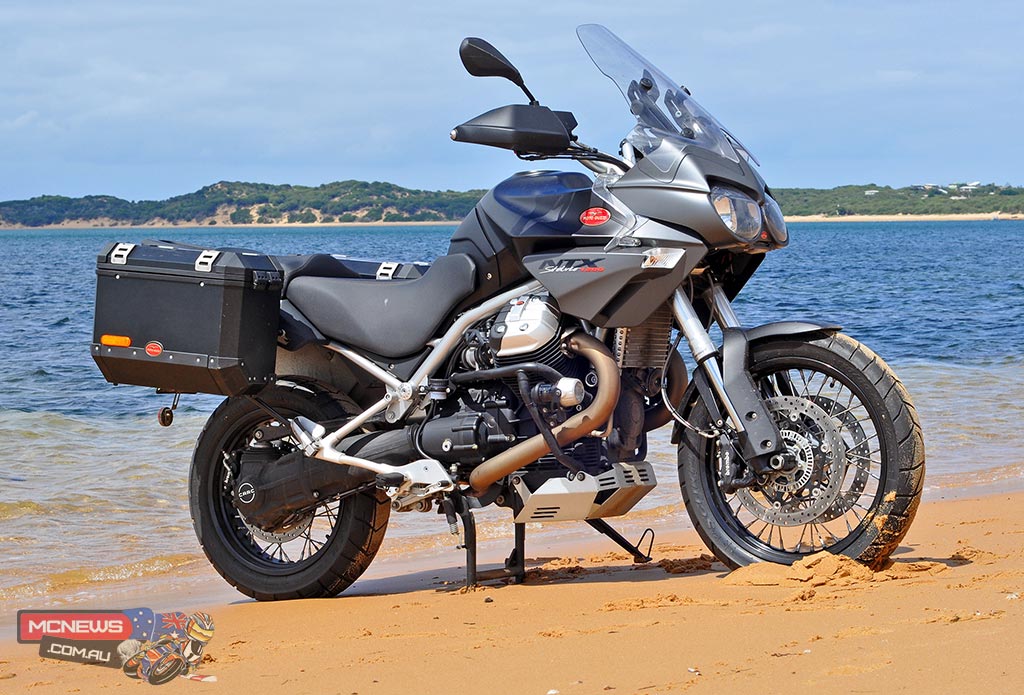
Still, the Stelvio had its fans, and I must admit that I too had somewhat of a soft spot for the latter generation NTX as pictured above. That big 90-degree air-cooled transverse V-Twin stirred the soul perhaps even more than a BMW Boxer. However when in the market myself around the time the Stelvio NTX was released, it was the fizzing ADHD kid that was KTM’s 990 Adventure R that actually got my money.
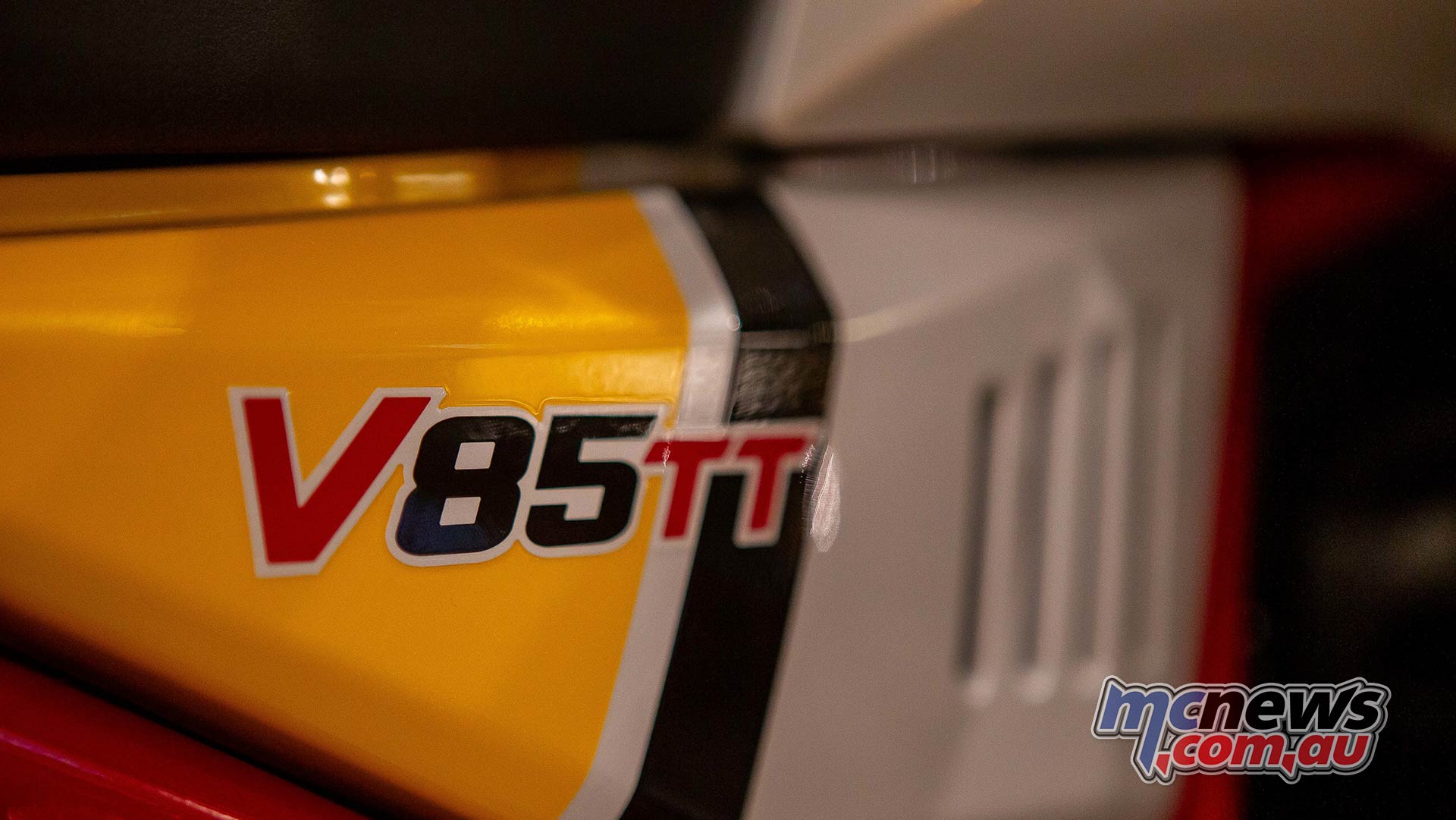
Anyways, enough of a history lesson, and reflections on my bike buying habits, lets get on to the eagerly anticipated new kid on the adventure block from Moto Guzzi, the V85 TT.
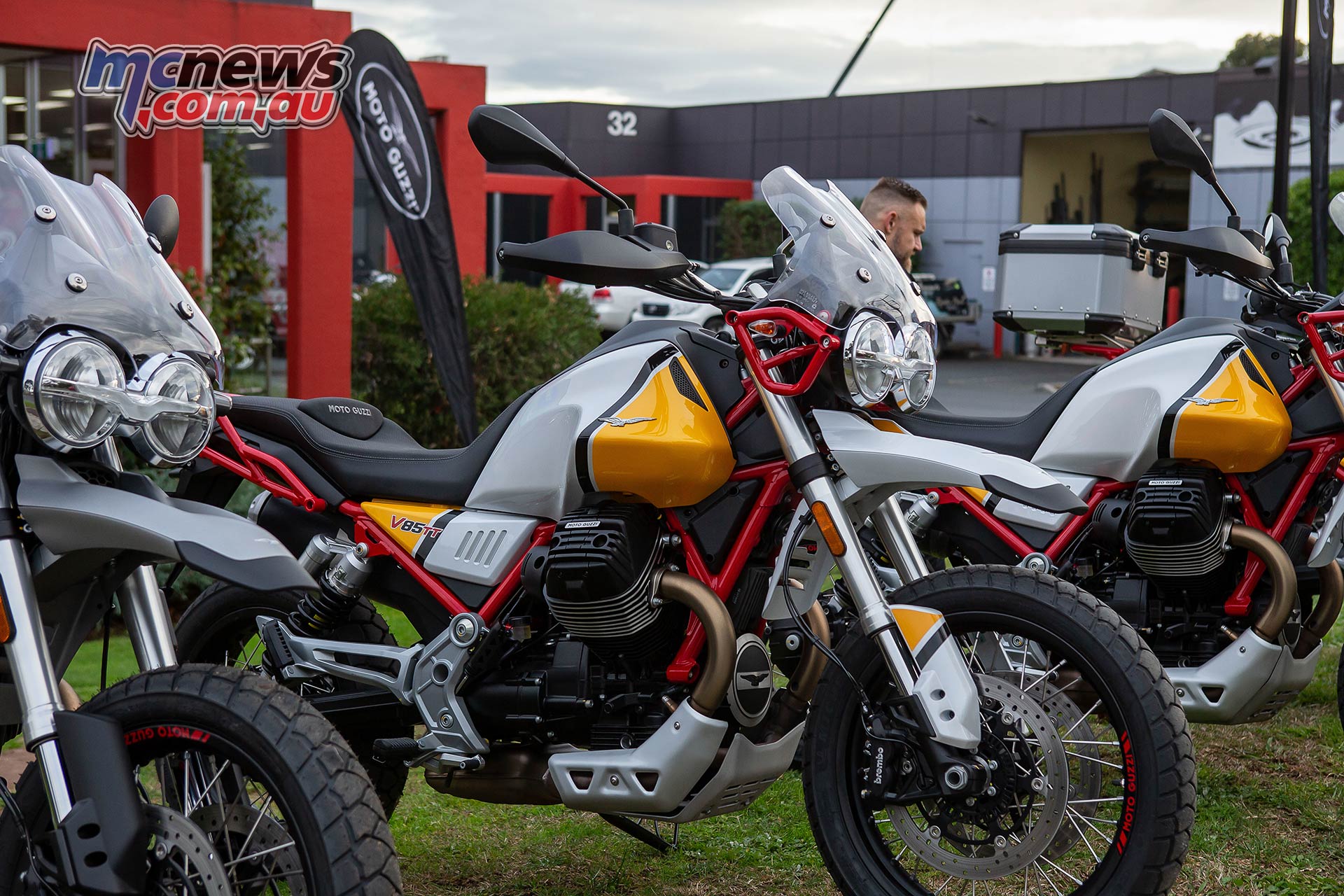
Produced in the beautiful northern Italian town of Mandello Del Lario, a fact proudly highlighted on the instrumentation of the V85 TT, the Moto Guzzi factory overlooks the glamorous Lake Como. Guzzi have been producing their machines in those glorious surroundings since 1921. Like most Italian companies the ownership of the brand has changed from time to time, and for the past 15 years Guzzi has benefitted from being under the stewardship of the Piaggio Group. Brands such as Aprilia are also under Piaggio’s purview, and in recent years Moto Guzzi has benefitted greatly from the tie-up, via a great injection of technology from their cousins over at Noale.

The new V85 TT even boasts the same Marelli 7SM ECU smarts as the 200+ horsepower Aprilia RSV4 sportsbike, along with traction control and ABS systems all linked to the fly-by-wire throttle. Importantly though, it is still very much a Guzzi.
Guzzis are different, and the V85 TT is a stark contrast to other options in the adventure-touring marketplace. This is perhaps is its most endearing character trait. Particularly in the technicolour dream-coat yellow-white-red-black colour scheme that Guzzi dub ‘Evocative’.
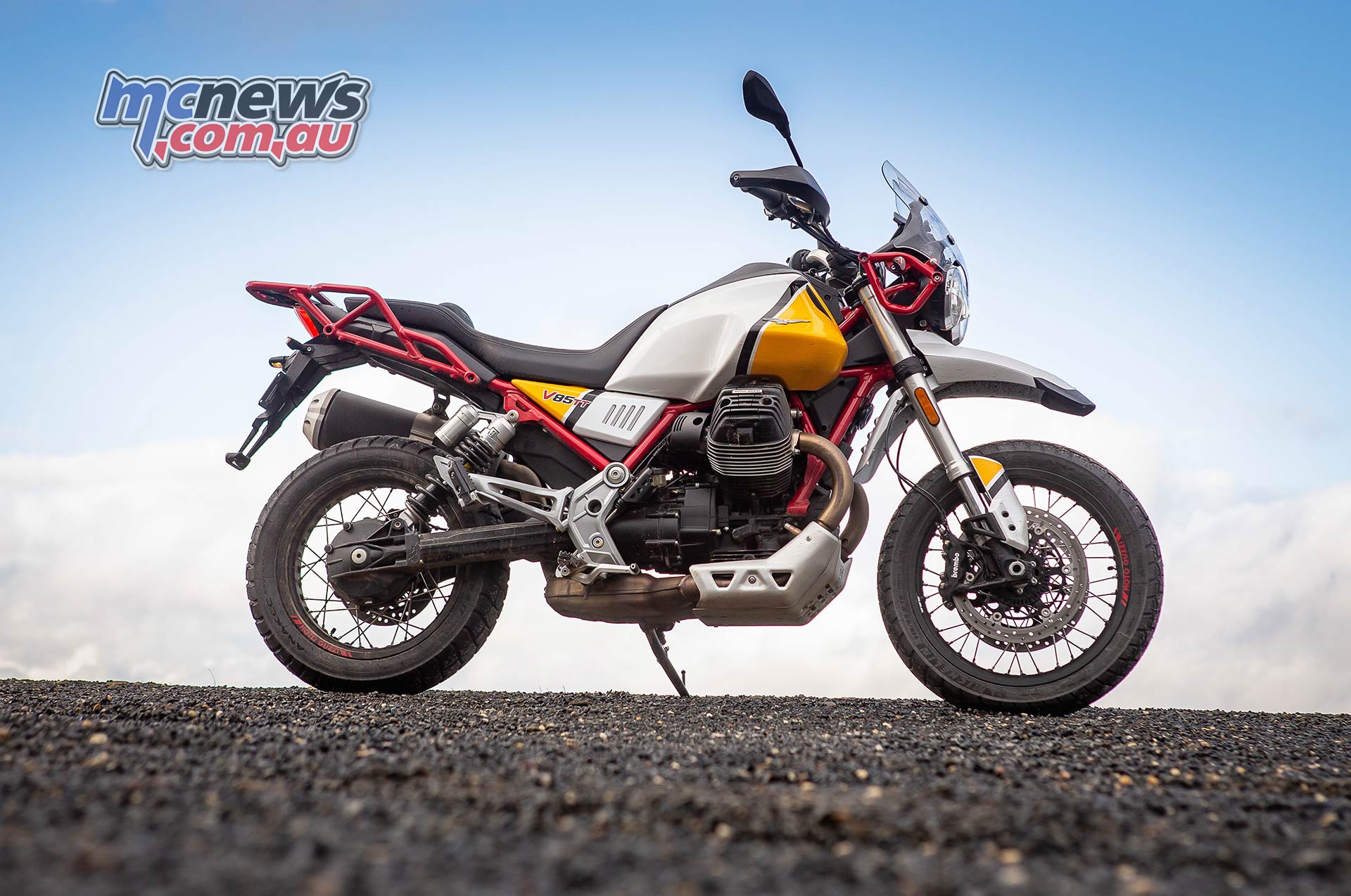
Some cruel bastards have dubbed the V85 TT in this colour scheme ‘Ronald McDonald’s bike’. Well I don’t like McDonalds (the burgers are better at Hungry Jack’s), but I do find the V85 TT quite tasty to my colour palette.
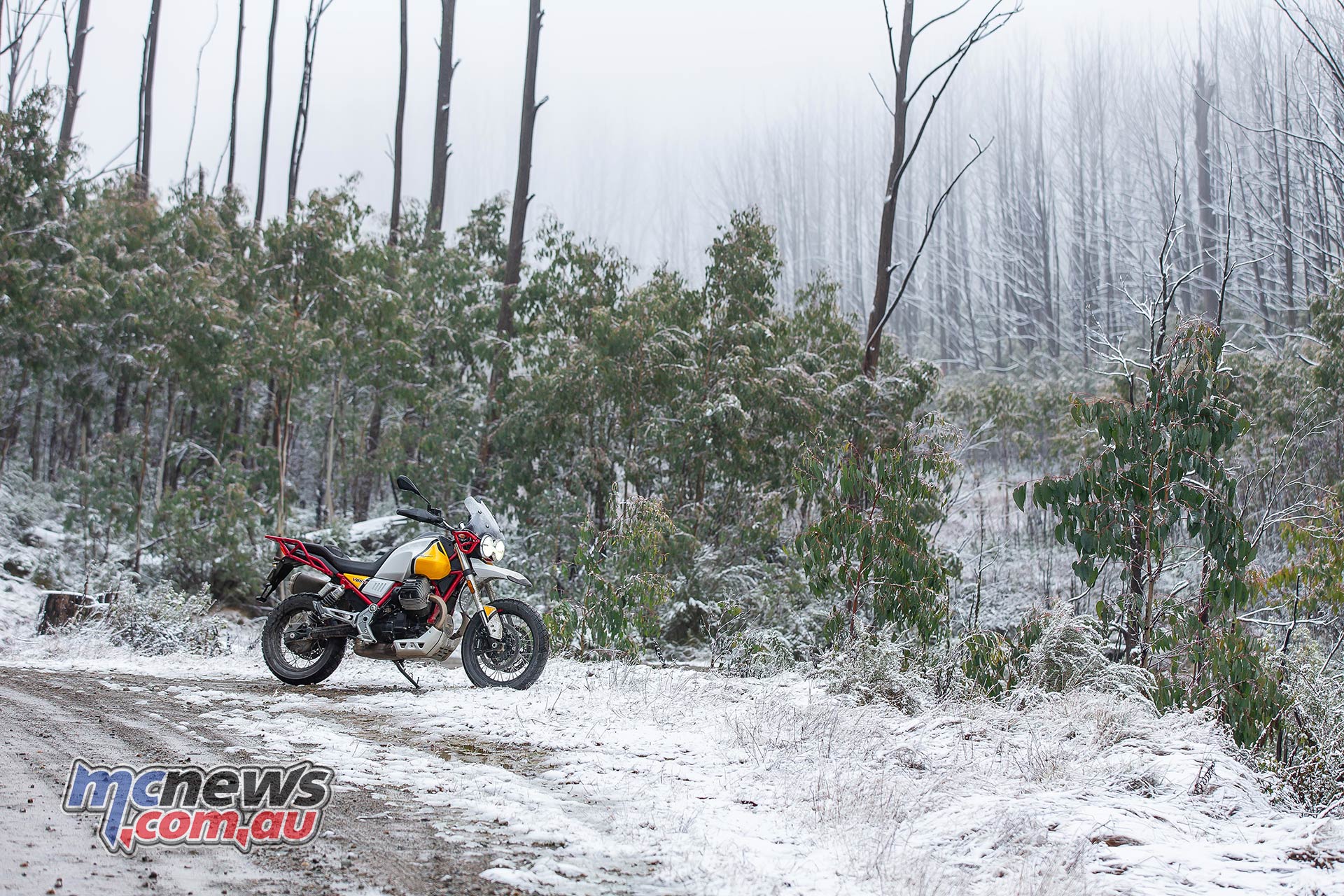
The quality of the paint finish on the steel trellis frame appears to be fantastic and this extends from the headlight and instrumentation supporting bracketry up front, to the rear grab-rails and luggage rack. It appears deep and lustrous enough to survive the tests of time, and I certainly hope it does.
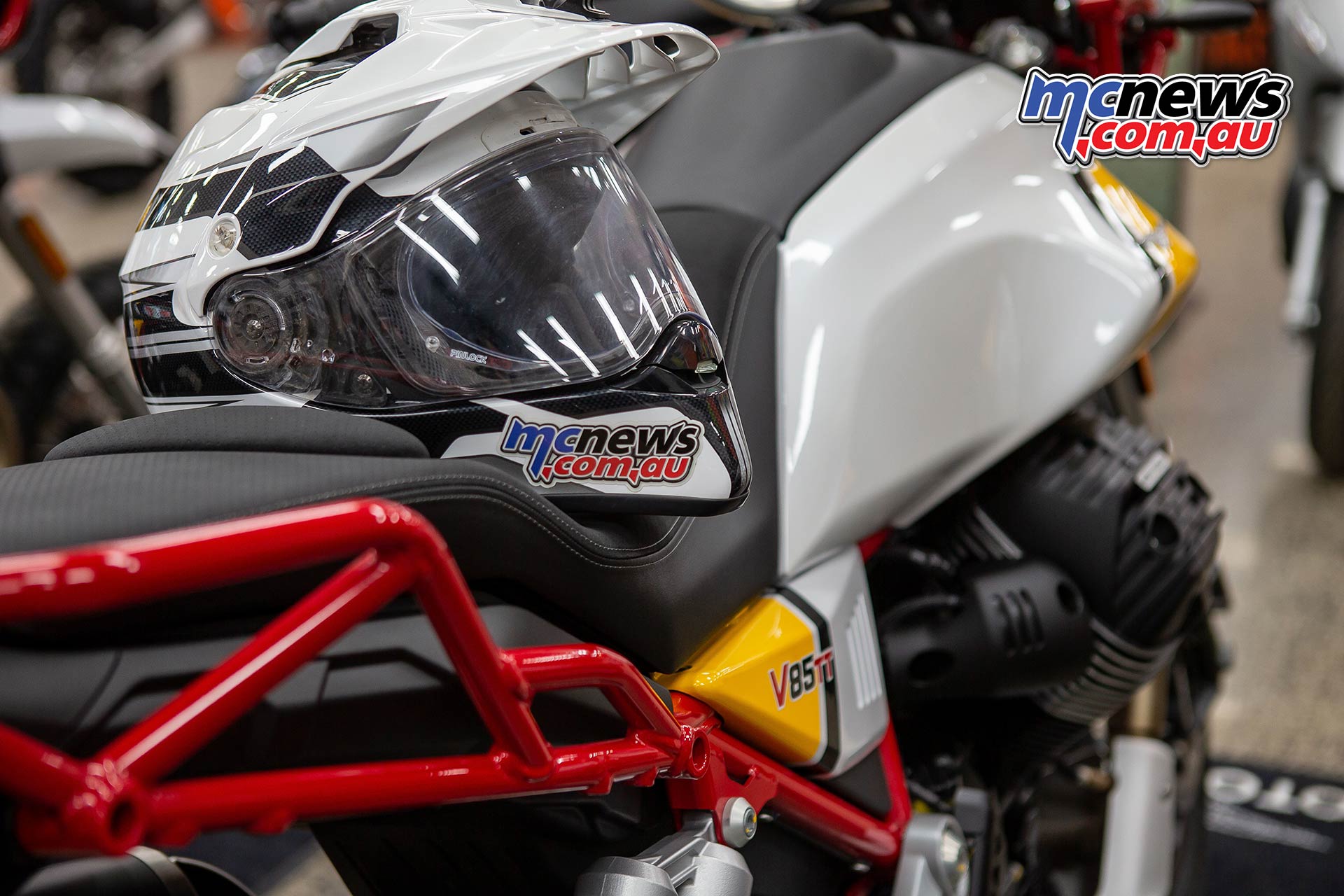
The 853cc V-Twin is a stressed member that helps form the pelvis of the spine frame while the swing-arm pivots directly off the gearbox before terminating in a shaft final-drive. The ‘jacking’ from the torque reaction as drive is transferred to the shaft has long been relegated to a more dark past of motorcycling history by all brands and the Guzzi exhibits no negative handling traits from its shaft-drive system.
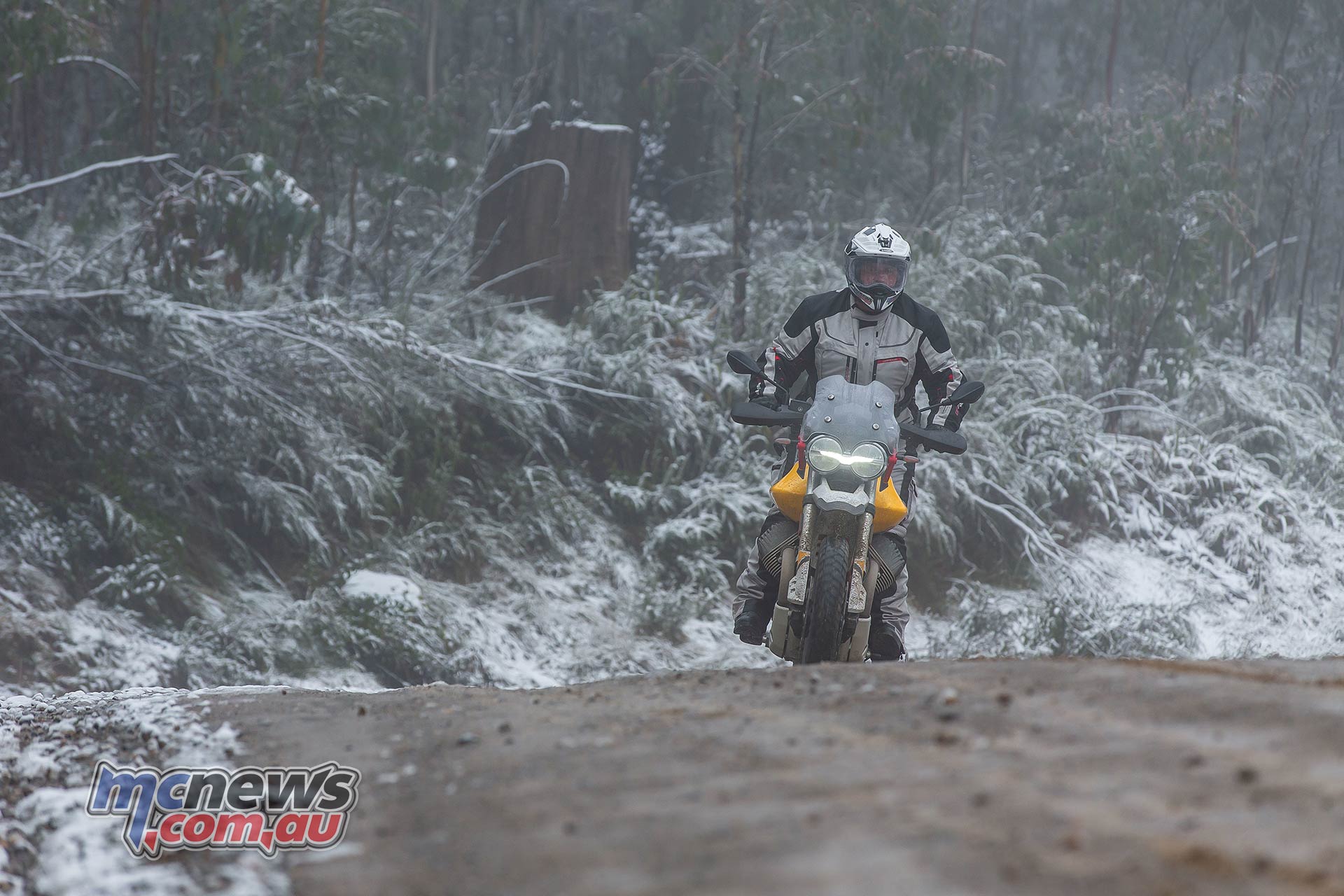
However I do find the V85 TT taller geared than I would prefer. And obviously with shaft drive you are stuck with that gearing as shortening the final drive ratio is not quite as simple as adding a few teeth to a rear sprocket, or dropping a tooth off the front.

Cruising at 100 km/h in sixth gear sees the lightest spinning crank I have ever felt in a Guzzi turning only 3750 rpm. It will pull 70 km/h in first and that means tight and tricky going will need plenty of left hand work to slip that dry clutch. Although, it must be said smooth mapping, a reluctance to stall, and a very light pull on that adjustable clutch lever through a nice smooth engagement doesn’t make this too great a chore. It was not all that long ago that BMW Boxers also ran a dry clutch and the smell of clutch in the air at times during the launch brought those memories flooding back. That’s not necessarily a negative, BMW ended up getting them right and I have never known Guzzis to have weak clutches. However, it is a point worth noting for those that are not accustomed to motorcycles that use a clutch system more akin to a car, instead of the regular wet multi-plate clutch system used in most motorcycles.
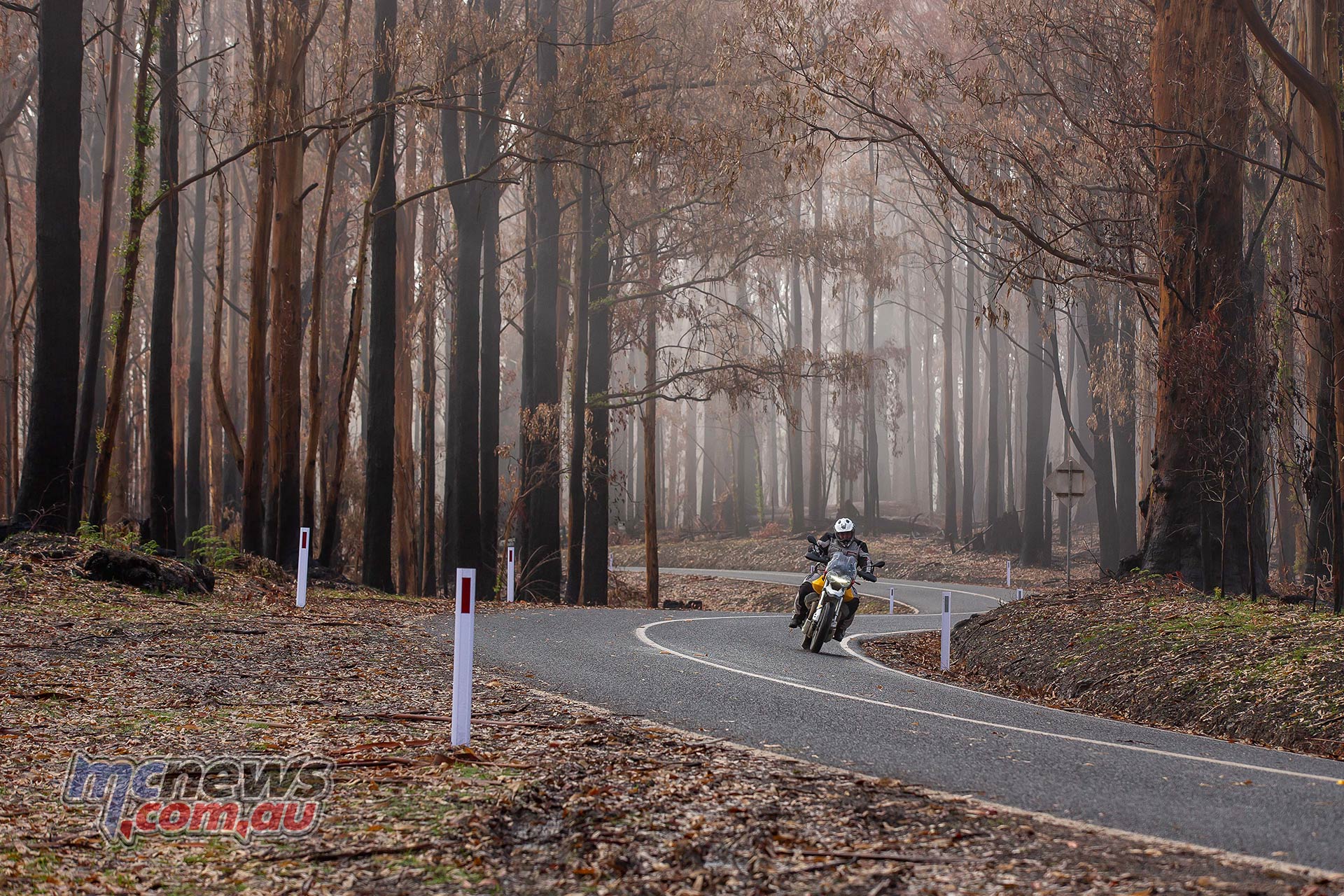
The transverse engine pulls quite willingly past 8000 rpm but I found myself often forgetting that 80 horsepower top end was there. The long legged gearing made revving the Guzzi that hard almost a conscious decision. Most of the time I was loping around below 5000 rpm and thinking ‘gee this engine doesn’t really pull all that hard’. Only to then force things past that marker to find an engine that actually surprises a little in the top end.
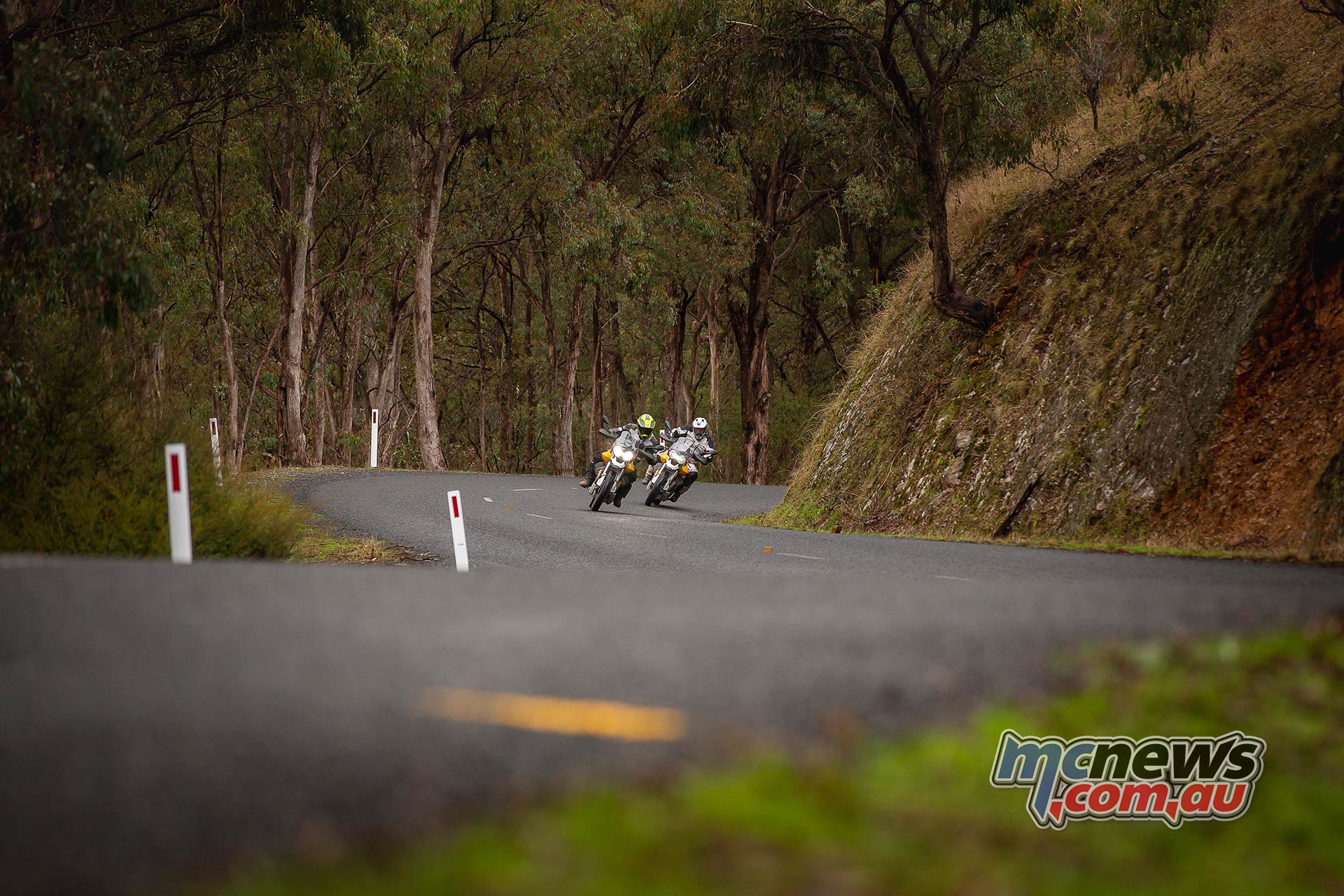
The official claims from Moto Guzzi quote 80 horsepower at 7750 rpm and 80 Nm of torque at 5000 rpm. The torque curve does not feel, to the seat of my DriRider pants, quite as broad as their (supplied) dyno chart suggests, but to be fair the engines were hardly broken in, and traditionally Guzzi engines do take some time to loosen up and give their best.
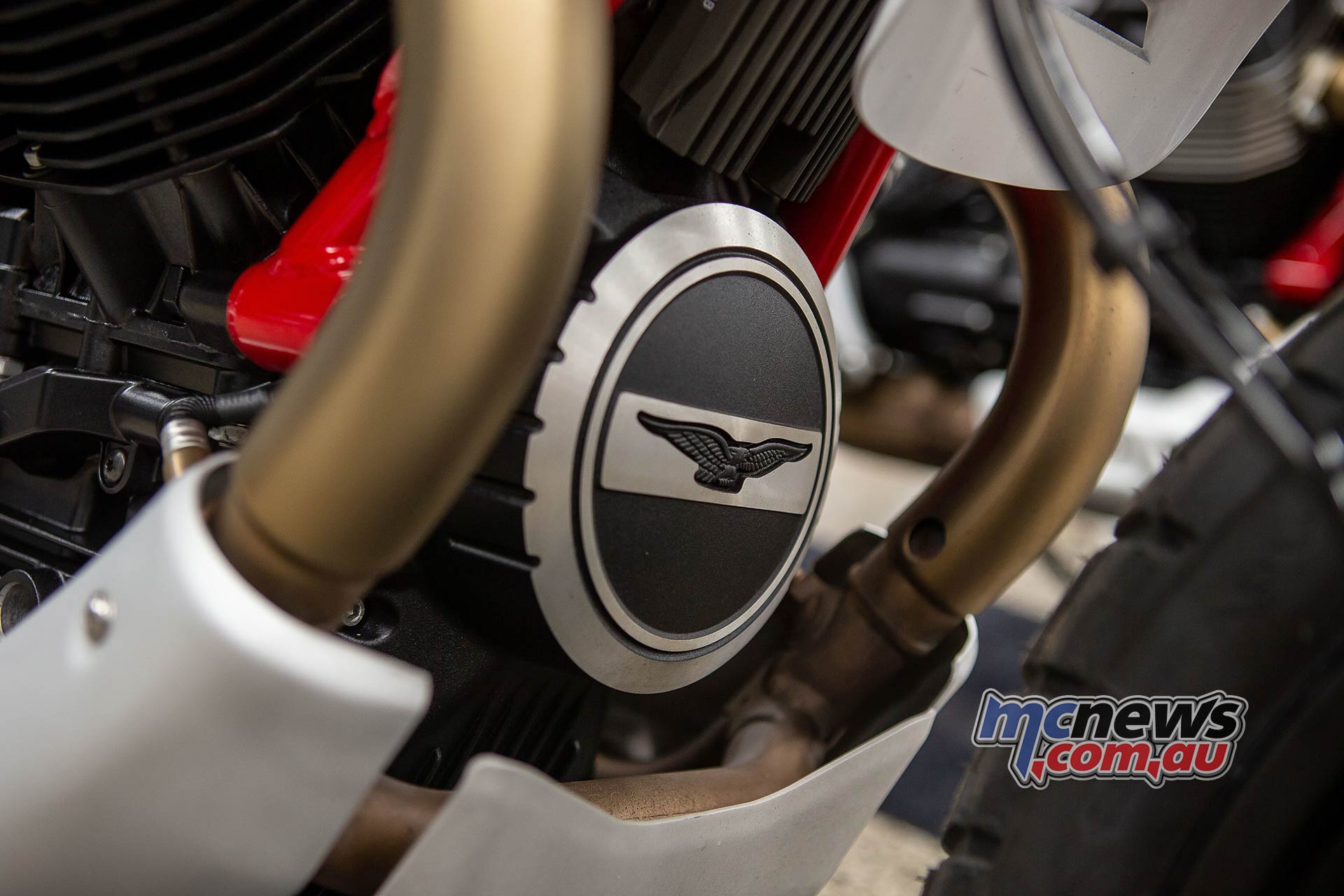
It is not as willing as the latest BMW F 850 GS, but is not too far off the outgoing F 800 GS engine. But with a more endearing character than the fluffy BMW 800 parallel twin ever mustered in its previous generation, before it got its new crank phasing for the latest 850 generation of the model that finally gave the BMW twin some bark and character.
Guzzi have lightened the crank compared to the ‘V9’ street-bike models that also utilise this new engine platform. Along with lighter forged pistons, Guzzi claim a 30 per cent reduction in reciprocating mass.
That would normally be a good thing, but to my mind what makes a Guzzi, a ‘Guzzi’, is a bloody heavy crank that makes you really feel those pistons pumping away mightily out each side of the bike.
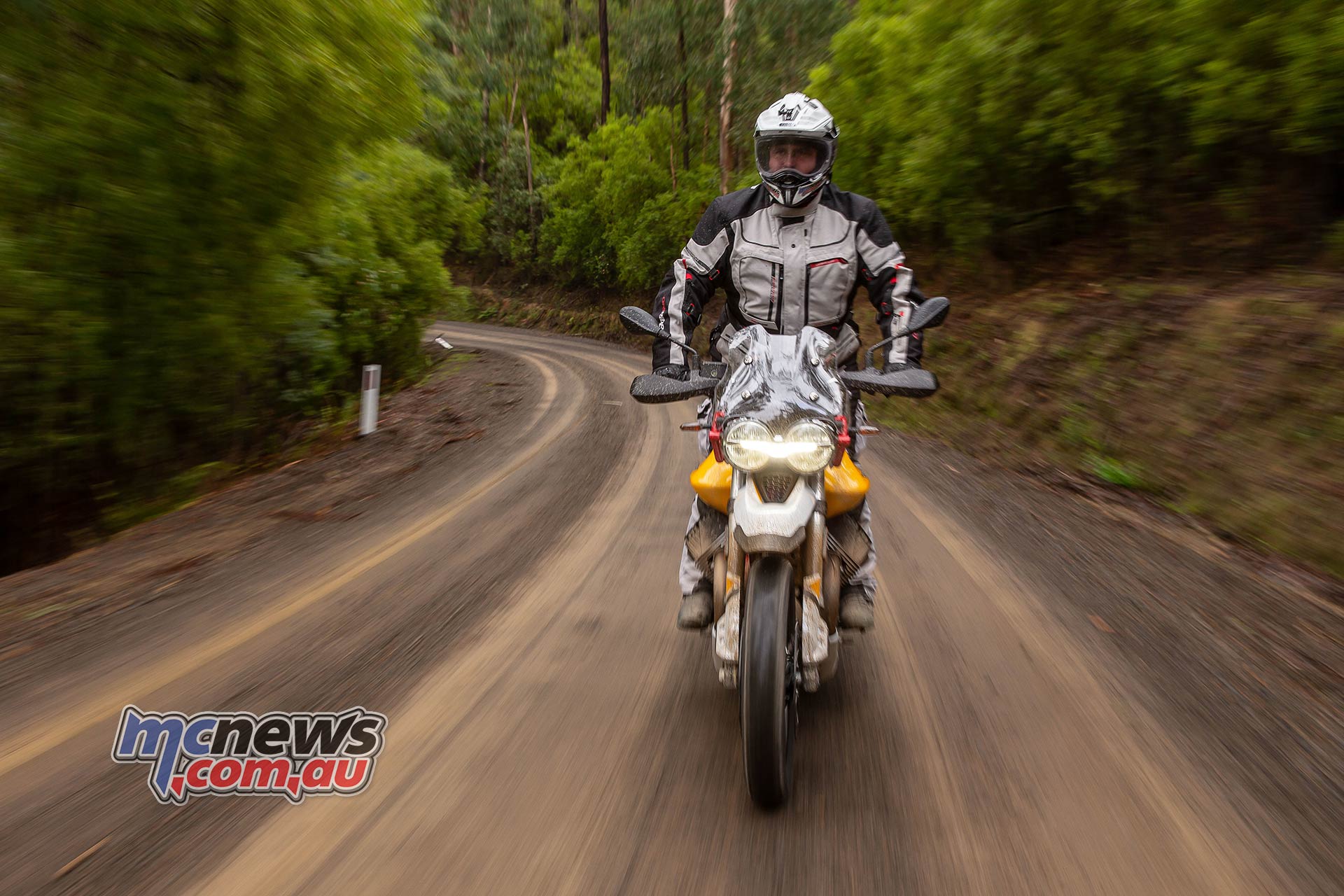
Granted, these 84mm slugs are a fair bit smaller than the 95mm pistons used in the outgoing 1200 Guzzi models. Lighter internals of course have benefits in regards to how quick the engine revs (even if that nature is somewhat hobbled by moonshot gearing), it also makes this Guzzi lose a little of its potential charm. Still, the engineering principles are sound and I would expect this push-rod engine, complete with roller cam followers, titanium inlet valves, virtual dry sump and a single 52mm throttle body will provide a long and trouble free service life. Thanks to its relatively simplistic lay-out I would also expect, and hope, that servicing the Guzzi will be an easy affair.
A deeply finned sump serves as an oil cooler and Guzzi claims the new engine is thermally efficient enough to not require an oil-heat exchanger or radiator. Thus this new engine is a rare bird indeed as we march forlornly towards Euro5 emission regulations. As the launch was conducted in single-digit temperatures we can’t tell you if the engine transmits too much heat to the rider. The rocker covers seemingly have some sort of second skin that prevented them from getting hot enough to warm my gloves during snow photo stops though!
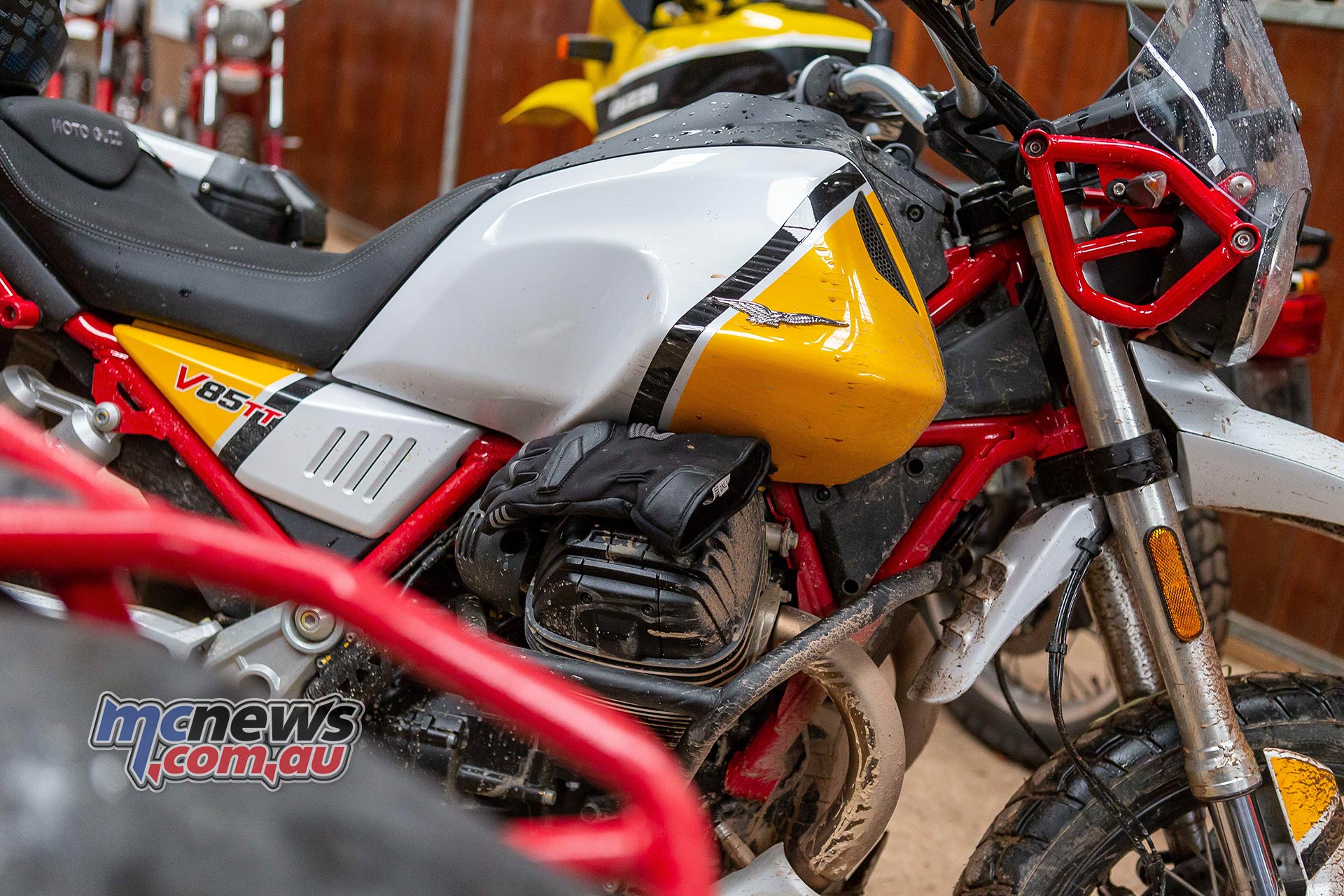
No doubt it is that clever Marelli ECU that enables Moto Guzzi to meet all looming emissions standards without the requirement for liquid cooling, and that alone deserves some major kudos. There might be hope for the DR650 yet!

It is also electronic smarts that a few years ago helped Guzzi rid themselves of a not so welcome trait that they were infamous for. Massive levels of engine braking that mandated any down-shifts be done slowly, deliberately and a long way before any approaching corner, if not to enter said corners sideways in a compression lock-up, have long been tamed by the move to ride-by-wire throttles some years ago. The V85 TT does not require a learned Guzzi specific riding technique in any way and is instead user friendly from the word go.
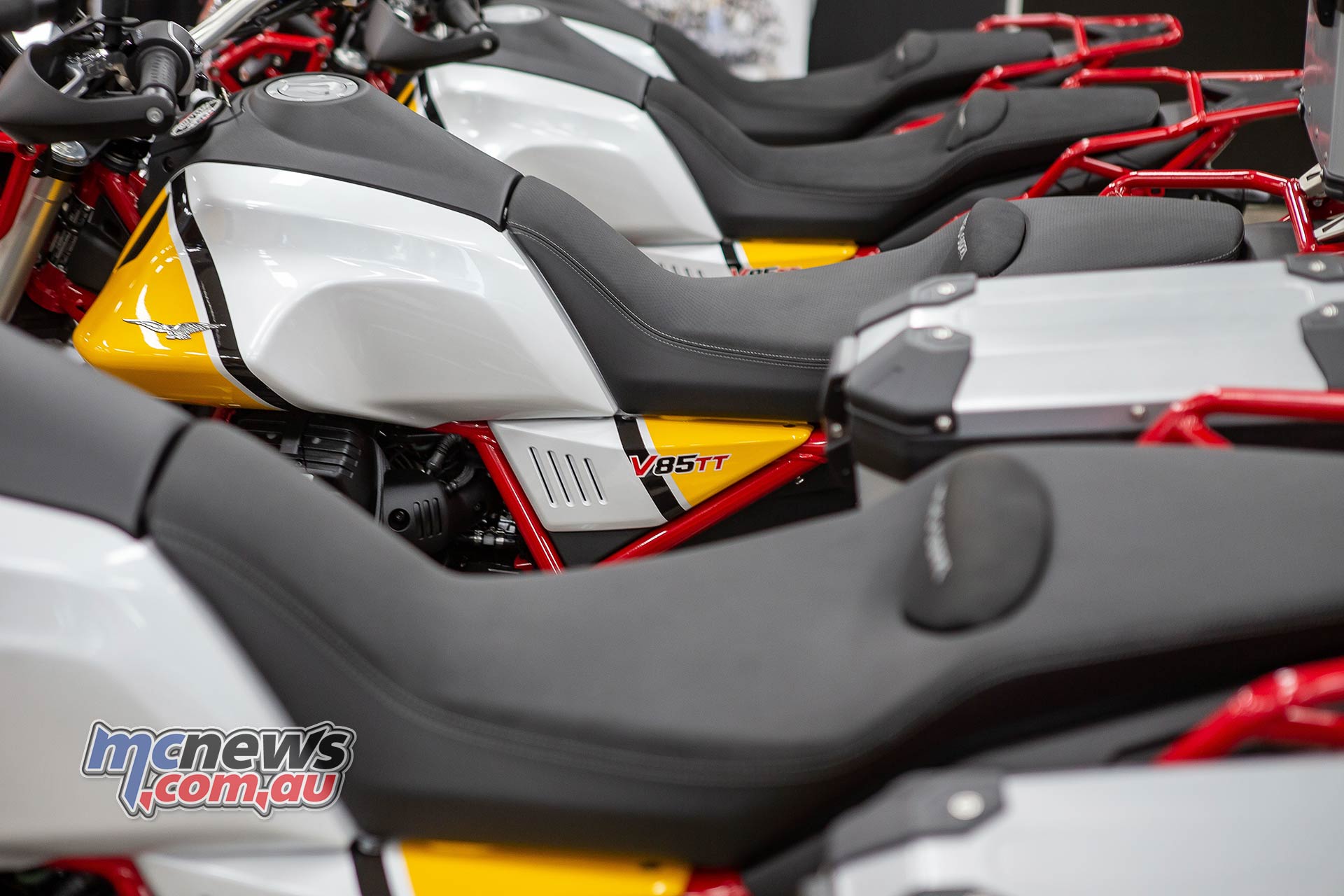
The riding position feels quite natural in most ways, except for the bars being exceptionally wide. The seat is beautifully finished and accommodated my ample buns quite nicely. At 830 mm the seat is also quite low while the pegs were at a good height and the vision ahead clear. The screen works well enough without being obtrusive and there is a larger screen on offer from the accessories catalogue if one so desires.
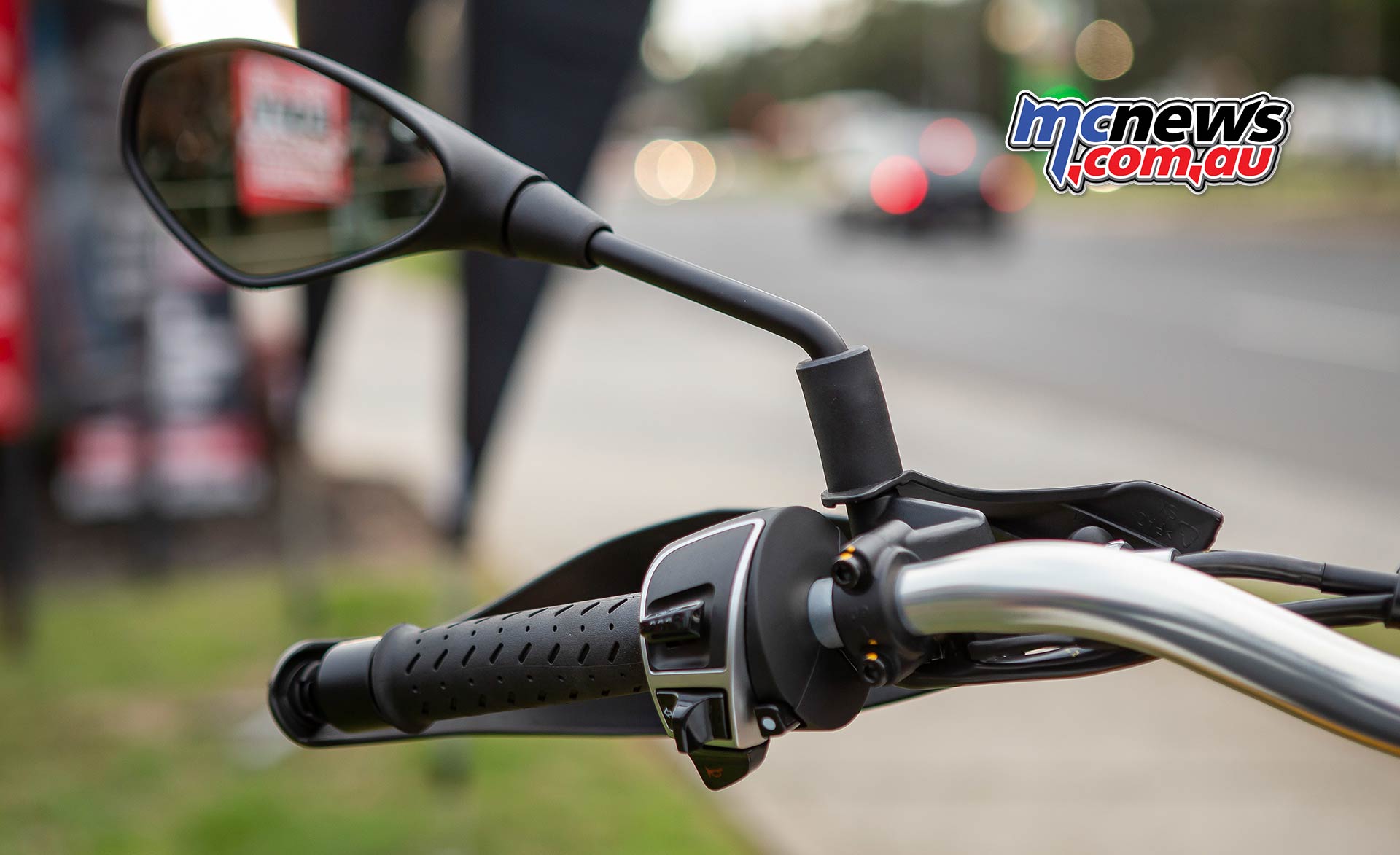
One positive from the ultra wide bars is that the mirrors are absolutely outstanding with a great field of rearward vision and zero vibrations at any speed. The pegs are rubber topped to help quell any vibes to your feet on long hauls and the rubber tops are removed by a single 10mm bolt when it is time to head off-road in wet conditions. And wet and cold conditions we certainly had!
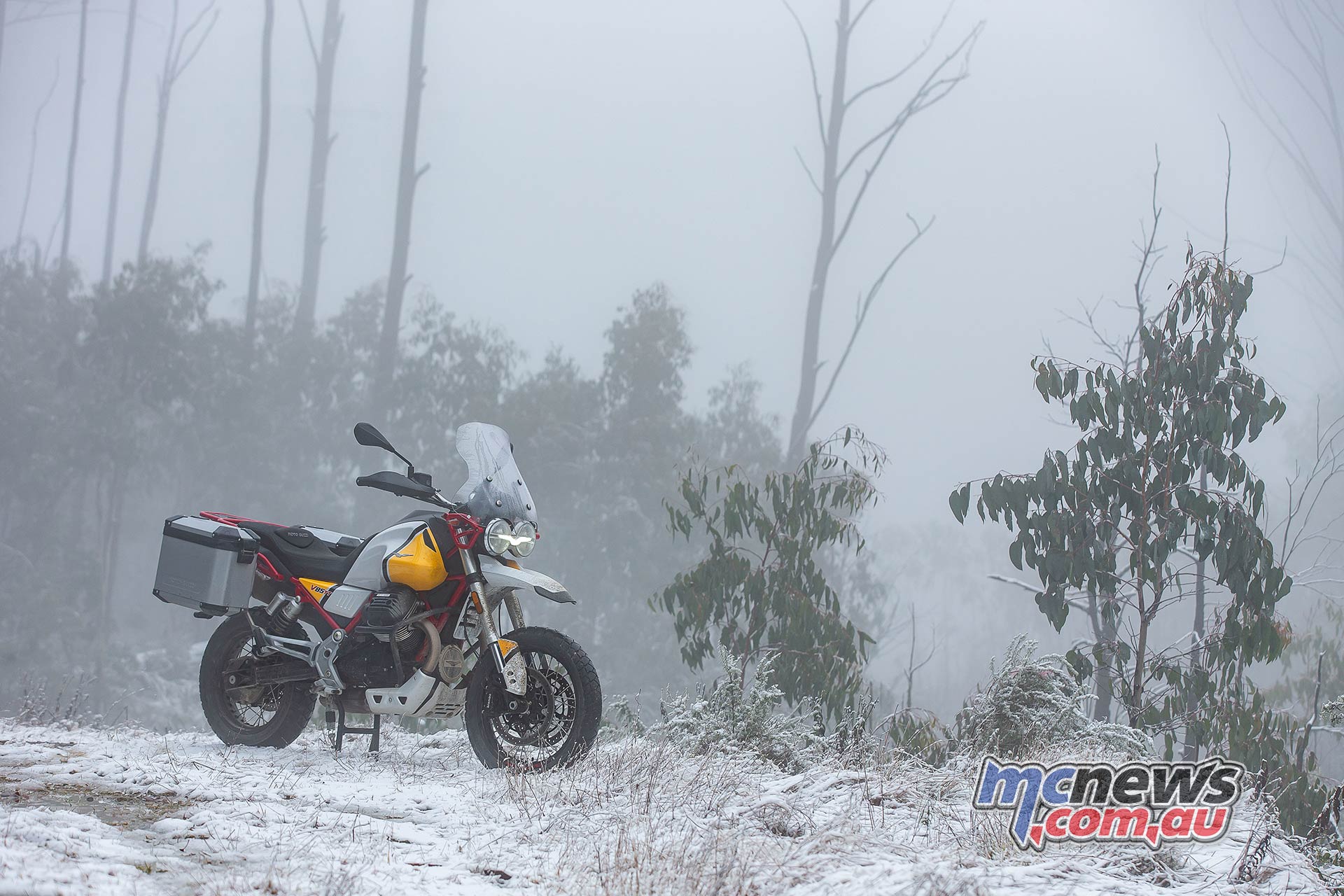
Unfortunately this made testing the suspension almost impossible. The near freezing temperatures meant that corners could not be attacked with any sort of vigour that would really put the suspension to the test. What I can say though is that over corrugation ripples off-road there was no sense of jack-hammering from the rear end, a trait all too common when you combine shaft drive with a shock not up to the job. The bike steered well, held a chosen line and showed no problematic characteristics, but we didn’t get the conditions required to really put the suspenders through the wringer.
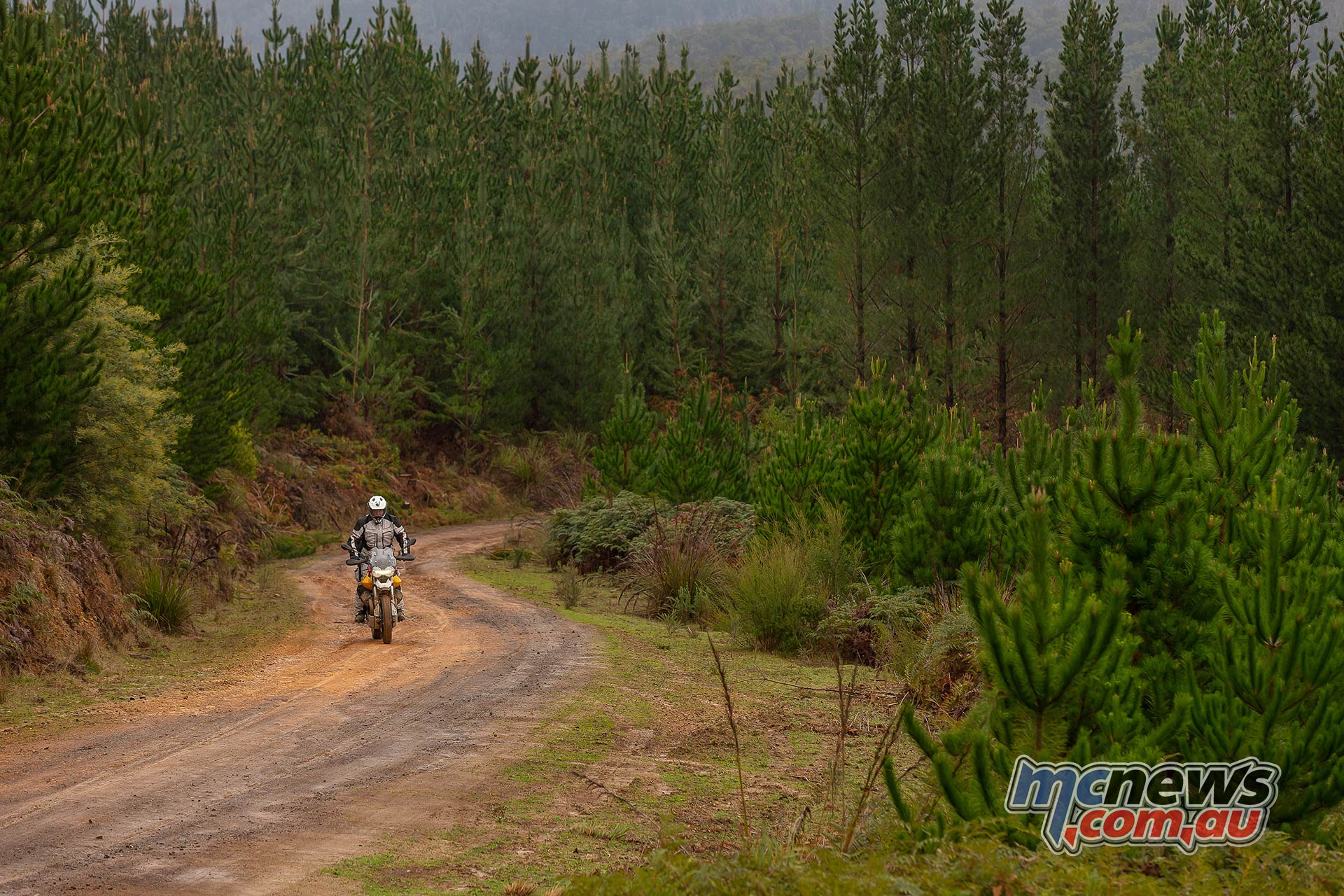
The rear suspension is also a little different than most with the shock off-set to the right and working directly on the swing-arm, negating the need for a bottom linkage. Yes, somewhat like the PDS system on a KTM, but in this case the shock is mounted to one side and attached to a fairly rearward point on the drive-shaft, which also doubles as the RHS of the swing-arm.
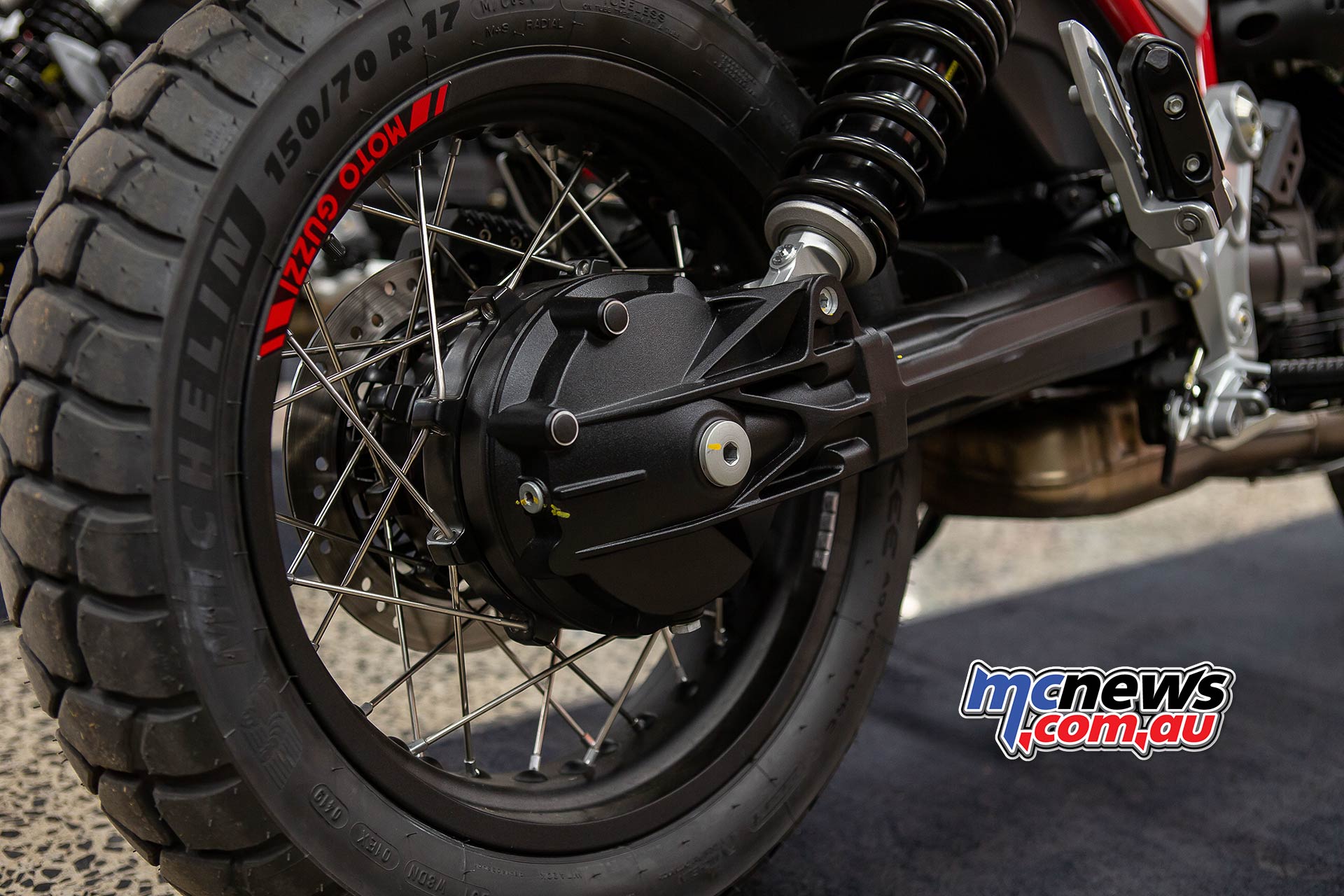
KYB supply both the shock and the forks that offer 170 mm of travel at each end. Preload and rebound damping is adjustable at both ends. Ground clearance is 210 mm.
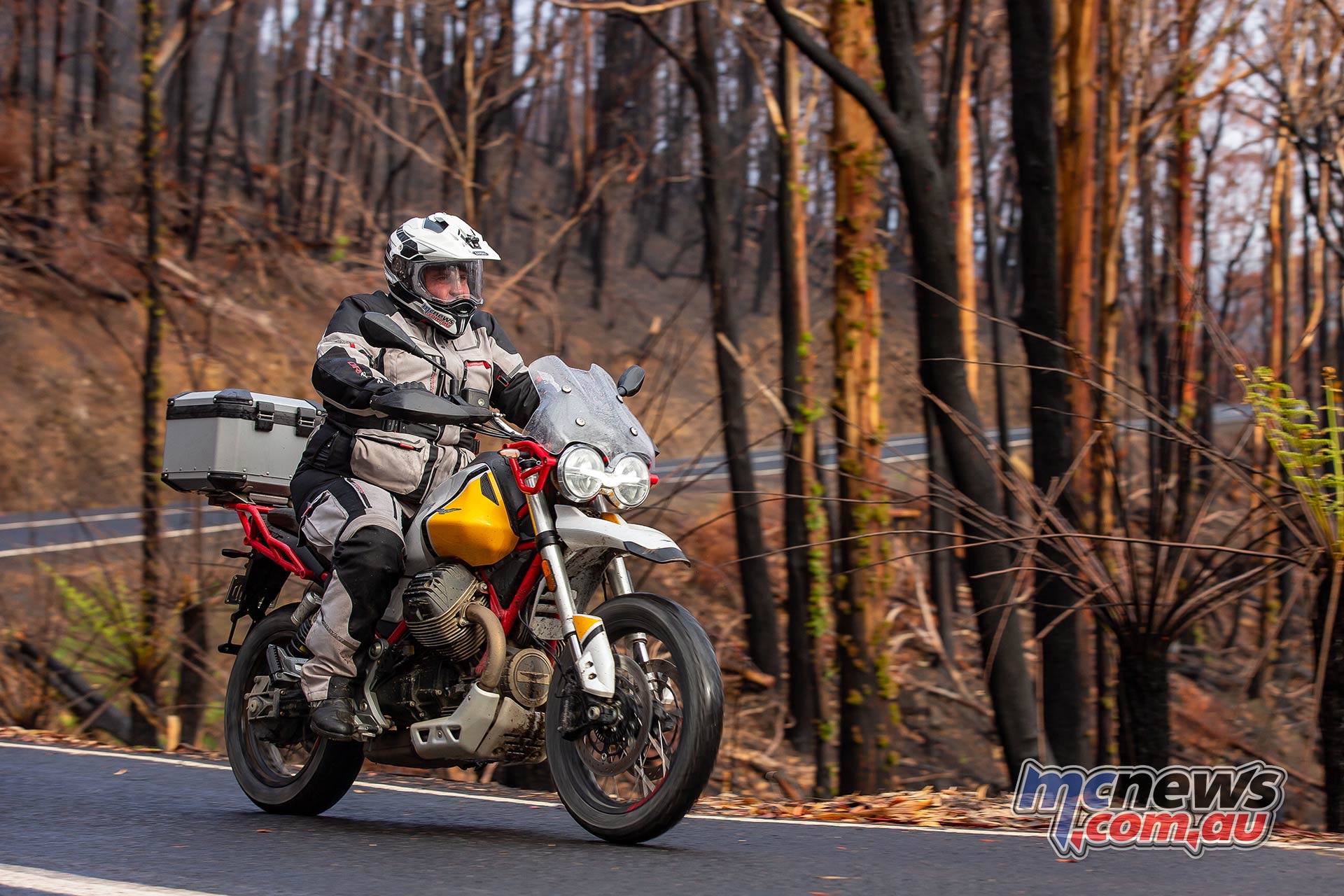
Outright braking power was also hard to judge on the surfaces we experienced but they did prove progressive and predictable in what were some seriously sketchy conditions.
Rolling on a 19-inch front and 17-inch rear the Tri-colour variants of the V85TT ride on Michelin Anakee rubber while the solid colour models are shod with Metzeler Tourance Next. The rims are spoked but require tubes, thus there is no tyre-pressure monitoring system available to add to what otherwise is a very comprehensive cockpit suite displayed on the full colour TFT dash.
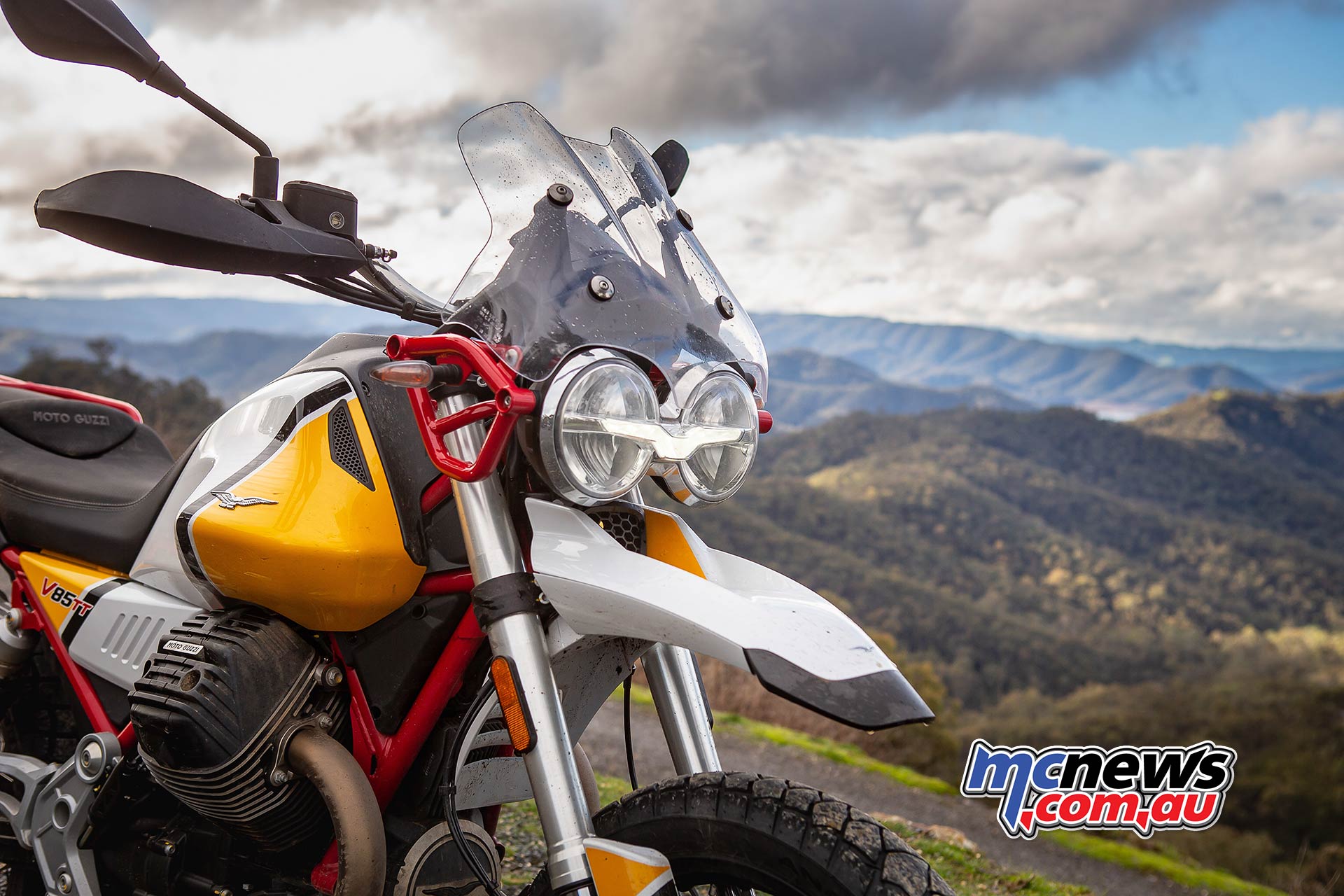
The other annoyance is that while there is a gear position indicator, there is no gear position sensor on the gearbox. Instead the ECU works out what gear it is in via a combination of RPM and rear wheel speed. This means that when you are sandwiched between two trucks after lane-splitting to the front of the traffic lights the neutral light does not go out until you start rolling, which had me on tenterhooks when the lights went green as to whether I was actually in gear or not. This is compounded by the fact that there is no audible or sensory feedback when you select first gear. It is a minor gripe, but still, it shitted me!
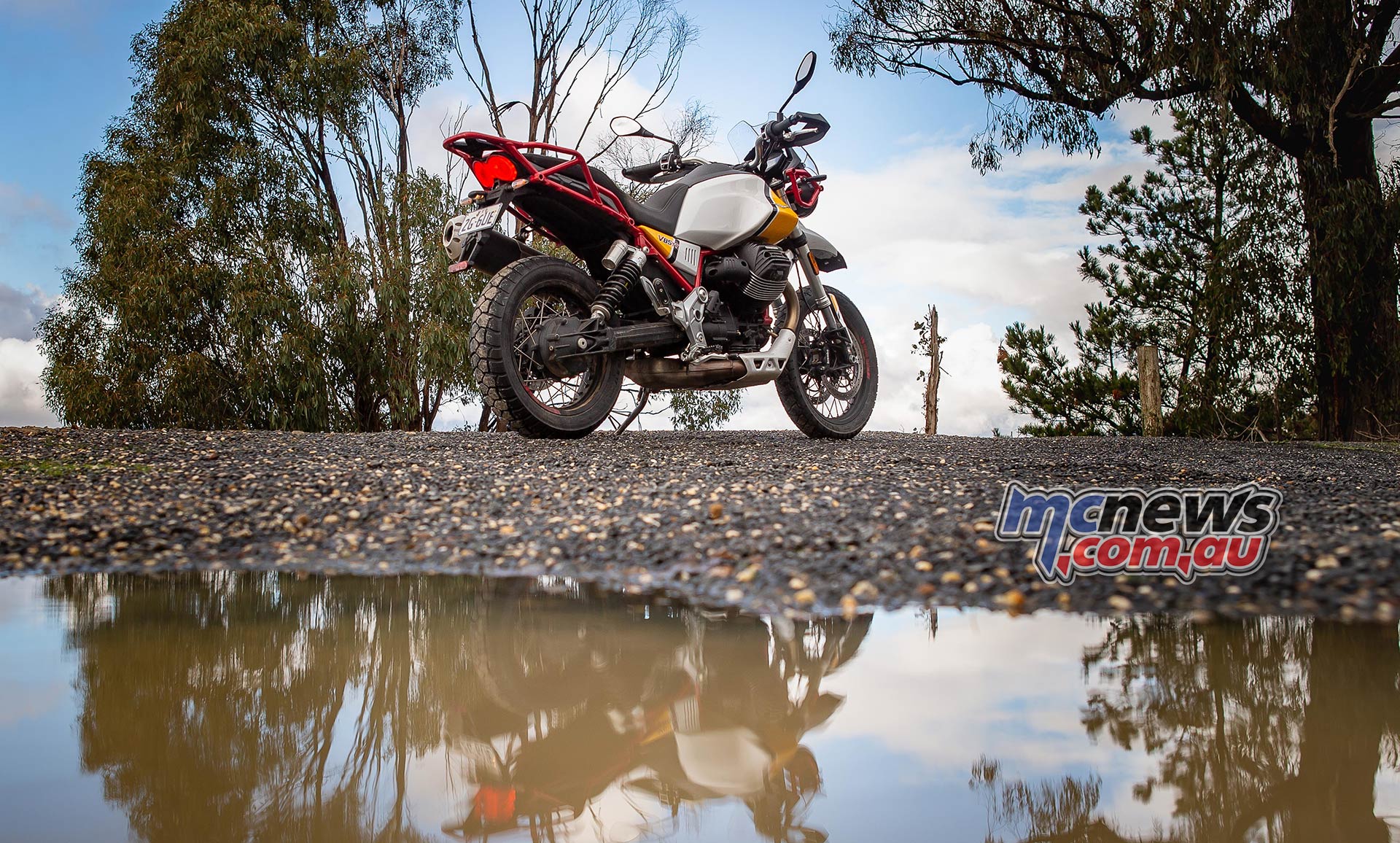
Sophisticated and switchable traction control and ABS systems married to individual riding modes are all standard while the instrumentation is both comprehensive and clear. A six-segment fuel gauge allows you to keep an eye on how much of that generous 23-litre fuel capacity is remaining. The ambient temperature display laughs at you as it registers 0-degrees while realising that Moto Guzzi had not fitted the optional heated grips to the bikes prior to the Australian launch.
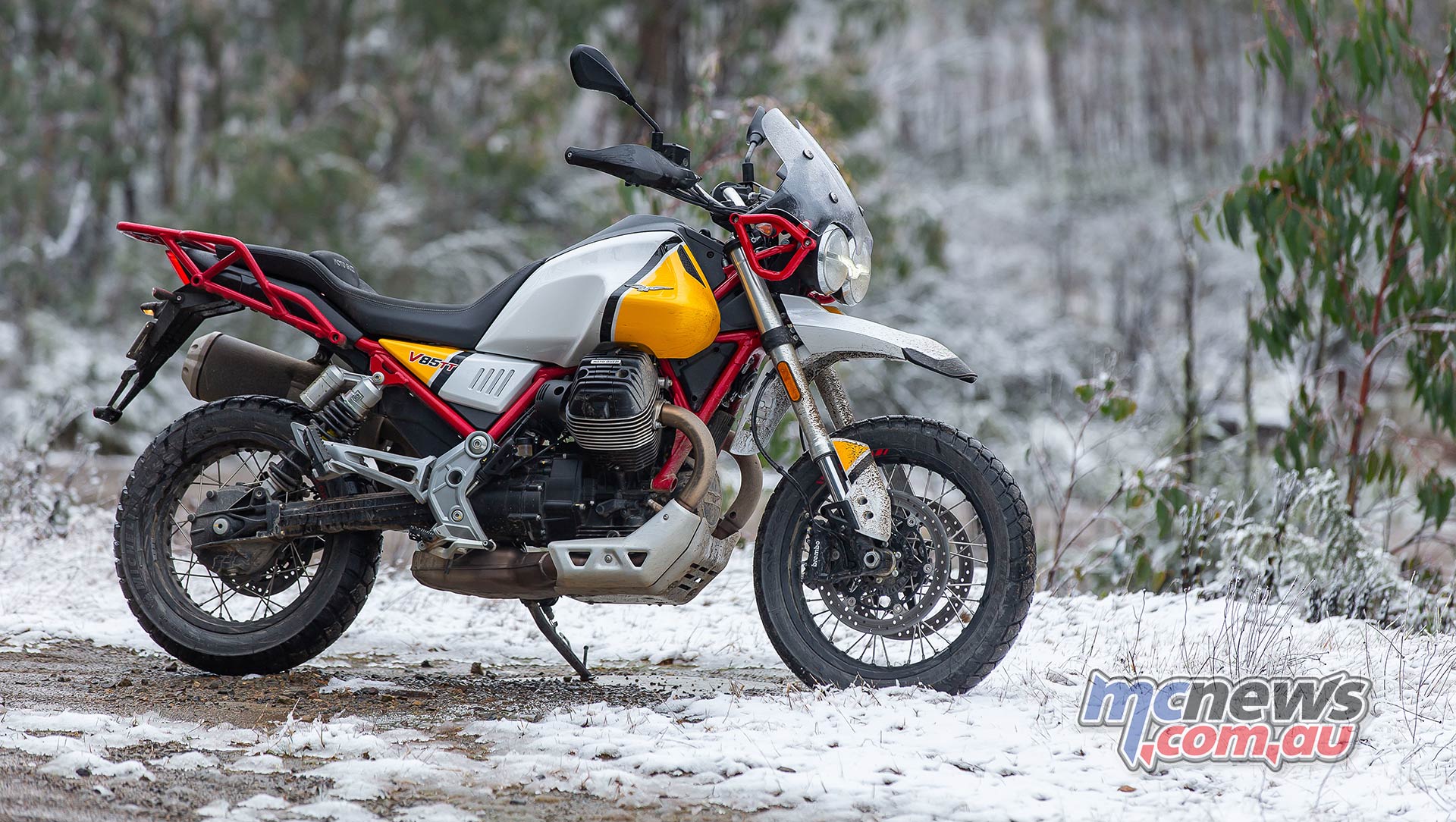
Further down the track Guzzi will add phone/intercom and navigation functionality to the dash via an app on your smartphone that will connect to the bike via bluetooth but this technology is not available at launch. Hopefully early buyers of the machine will be able to retrofit this at a modest cost when it becomes available later this year.
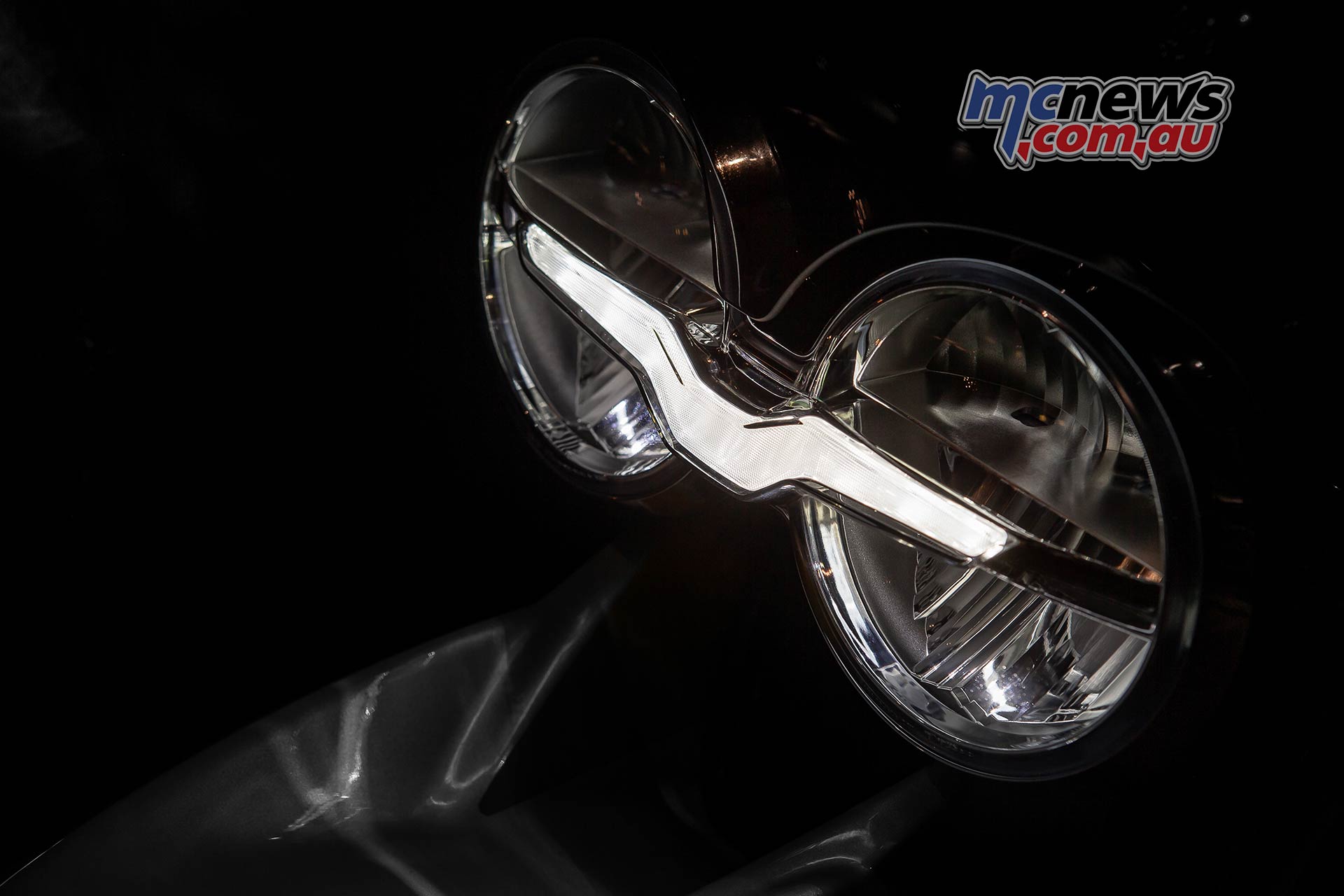
In the adventure-touring segment Moto Guzzi are providing something that is distinctly different. For those that speak Guzzi fluently, from previous experiences with their unique V-Twins, I believe you might miss the loping gait of that heavy crank throw, but otherwise there is still enough Guzzi flavour to savour.
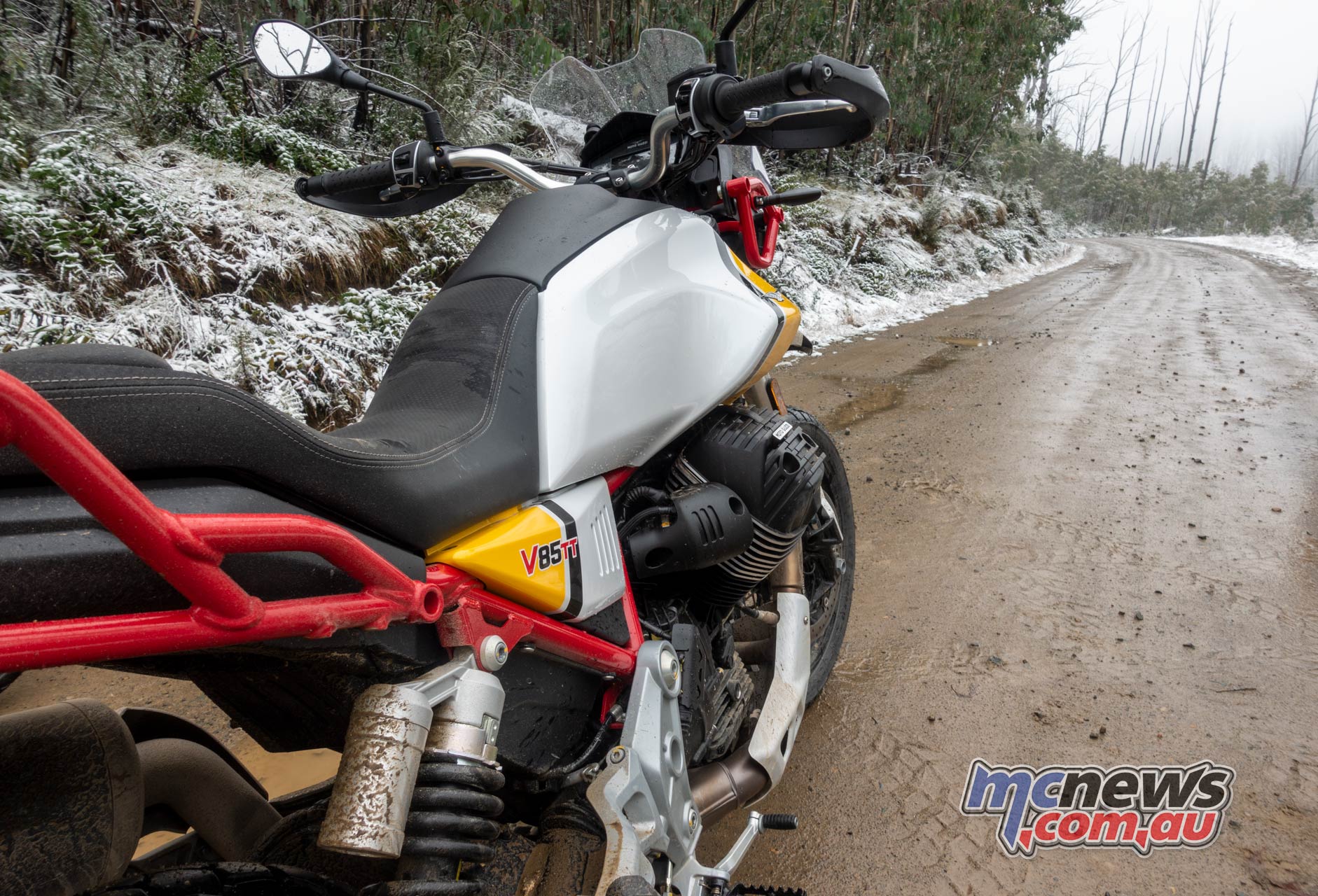
It is not an off-road supremo to the level of a GS, or a competitor for the coming more hard-core Tenere 700 Yamaha or the new 790 Adventure from KTM. It is an all-roads touring machine that opens up a little more horizons to riders who are in to the softer level of adventure, Guzzi makes no pretentions of this being otherwise.

The price of admission for the single colour option V85 TT machines is $20,690 ride away while the Tri-Colour variants command a $700 premium. That is getting up there for a mid-capacity touring machine but that is the price you pay for something a little bit different I guess. The V85 TT certainly stands out from the crowd, and I don’t mind being a bit different….
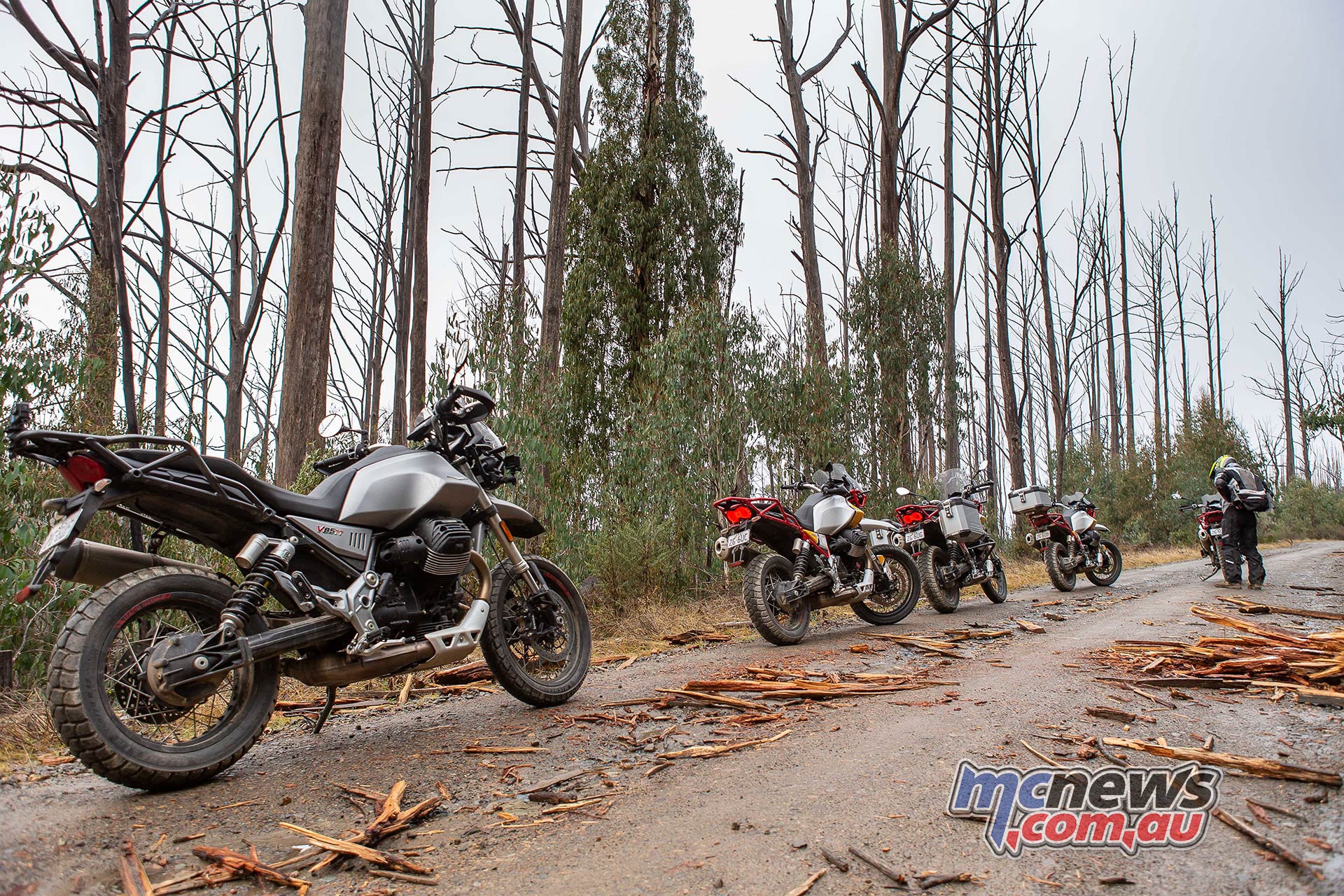
Moto Guzzi V85 TT Specifications
| ENGINE | ||
| Type | 4 stroke, 4 valve 90° V-twin with twin spark ignition | |
| Cooling | Air | |
| Engine capacity | 853 cm³ | |
| Bore and stroke | 84 x 77 mm | |
| Compression ratio | 10,5 ± 0,5 : 1 | |
| Idle engine speed) | 1300 ± 100 rpm | |
| Maximum power | 59 kW (80 HP) at 7750 rpm | |
| Maximum torque | 80 Nm at 5000 rpm | |
| Fuel system / Ignition system | Magneti Marelli 7SM2 electronic fuel injection; 52 mm diam. ride-by-wire throttle body, Magneti Marelli injectors, two lambda probes, torque control | |
| Start-up | Electric | |
| Spark plugs | NGK IR MR8BI-8 | |||
| Exhaust system | stainless steel, 2-in-1 type, three-way catalytic converter with double lambda probe | |||
| Emissions compliance | Euro 4 | |||
| Transmission | ||||
| Gearbox | mechanical, 6 speeds with foot lever on the left hand side of the engine | |||
| Gear ratio values | 1st 16/39 = 1 : 2,437 2nd 18/32 = 1 : 1,777 3rd 21/28 = 1 : 1,333 4th 24/26 = 1 : 1,083 5th 25/24 = 1 : 0,96 6th 27/24 = 1: 0,888 | |||
| Primary drive | With gears, ratio 18/23 = 1 : 1,277 | |||
| Final drive | with cardan shaft, ratio 8/33 = 1 : 4,125 | |||
| Clutch | single disc dry clutch with flexible coupling | |||
| Fuel supply | Electronic fuel injection (Marelli 7SM2) |
| Final drive | Cardan shaft / ratio 8/33 = 1: 4,125 |
| Cooling | Air |
| Frame | High strength tubular steel frame. |
| Gearbox | Mechanical 6 speed transmission, with shift pedal on left hand side of engine |
| Steering rake angle | 25,7° |
| Trail | 128.3 mm |
| Chassis | ||
| Front suspension | 41 mm diameter telescopic hydraulic fork Stroke 168 mm | |
| Rear suspension | Die-cast light alloy swingarm with 1 shock absorber adjustable spring preload and hydraulic rebound. Stroke 102 mm, 170mm travel | |
| Front brake | 320 mm stainless steel floating disc, radial calliper with four opposing 32 mm pistons | |
| Rear brake | 260 mm stainless steel disc and floating calliper with two 22 mm pistons | |
| Front wheel | 2.5″ x 19″ |
| Rear wheel | 4.25″ x 17″ |
| Front tyre | 110 / 80 R19 59V Inflation pressure: 2,5 bar |
| Rear tyre | 150 / 70 R17 69V Inflation pressure: 2,8 bar |
| Fork oil – right stem | 446 cm3 Level from sleeve edge: 144 mm |
| Fork oil – left stem | 360 cm3 Level from sleeve edge: 143 mm |
| Front wheel | 2.5″ x 19″ |
| Rear wheel | 4.25″ x 17″ |
| Front tyre | 110 / 80 R19 59V Inflation pressure: 2,5 bar |
| Rear tyre | 150 / 70 R17 69V Inflation pressure: 2,8 bar |
| Maximum Length | 2240 mm |
| Maximum width | 950 mm |
| Height (at adjustable windshield) | 1300-1325 mm |
| Wheelbase | 1530 mm |
| Kerb weight | 229 kg |
| Max. vehicle load | 448 Kg (rider + passenger + luggage) |
| Capacity | |
| Fuel tank (including reserve) | 23 ± 1 L |
| Fuel tank reserve capacity | 5 ± 0.5 L |
Moto Guzzi’s tradition of adventure
Moto Guzzi boasts a solid off-road tradition and the acronym ‘TT’ stands for “tutto terreno” (all terrain) and builds on a tradition that was established by the marque with their Gold Medal winning ISDE machines in the 1930’s. In 1957, Guzzi offered the Lodola Regolarità, followed by the Stornello Regolarità in 1962.
Moto Guzzi took on the Paris-Dakar in 1985 with the V65 Baja and the following year with the V75 Baja, where they proved robust and reliable.
The high front mud-guard and double front head-light in the V85 TT are reminiscent of the NTX 650 from 1996 and the Quota 1000 from 1989.





















